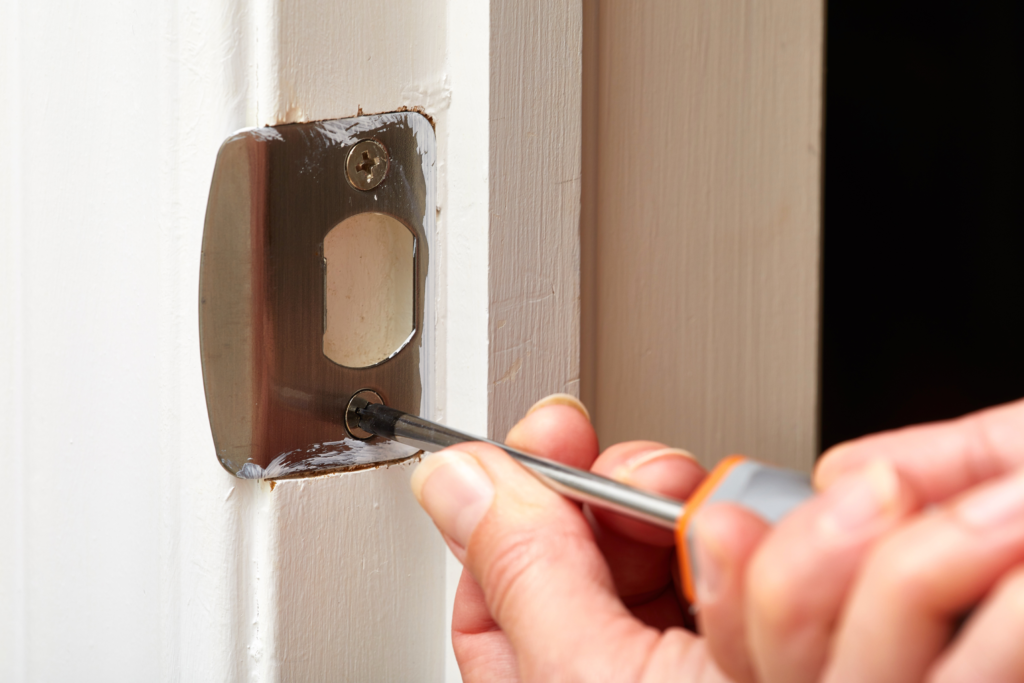Want to make your door snap shut securely every time? This easy-to-follow guide demystifies how to install door strike plate, a simple home improvement project that enhances door security. You’ll learn to select the right strike plate, gather tools, and install everything correctly. No fuss, no specialty tools required—just straightforward steps to get the job done right.
Key Takeaways
- A correctly chosen strike plate is crucial for door security, aligning with a door’s bore holes and constructed from materials suitable for the door frame, door thickness, and lock type.
- Installation of a strike bar requires careful preparation, precise positioning, and strategic planning, including the use of longer screws for a secure attachment to the doorjamb.
- Post-installation, it is important to test the door latch and strike plate alignment, make any necessary adjustments, and apply additional home security measures such as long screws, additional locks, and consulting professional locksmith services.
Don’t wait to improve your home or business security! Silver Eagle Locksmith offers a wide range of locksmith services in Las Vegas, Henderson, and North Las Vegas, NV. We can help you with lockouts, rekeying, lock replacement, door strike plate installation, and more. Call us today at 702-539-9581 for fast, reliable service from our licensed locksmiths.
👉Also Read: Securing Your Space: The Importance of Las Vegas Lock Change Service
Choosing the Right Strike Plate for Your Door
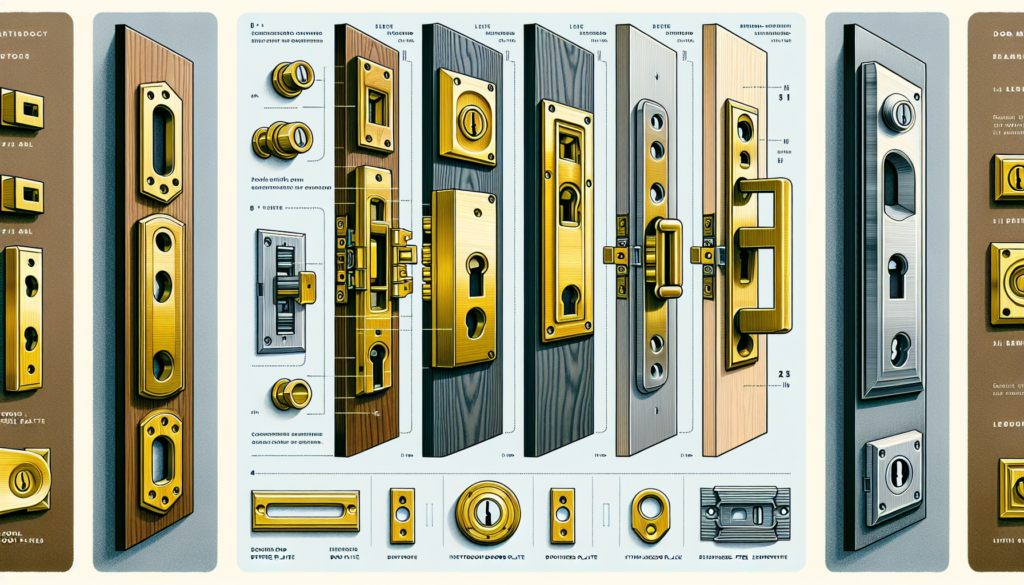
Every layer counts when securing your home. The strike plate is your door’s silent sentinel, engaging the latch or bolt from your lock to keep the door steadfastly closed. But not just any plate will do. It must be in harmony with your door’s face bore and edge bore to ensure the lockset performs flawlessly. Often, the best match is the strike plate that comes with your lockset, designed to fit like a glove with the correct hole size for the latch and usually accompanied by a handy template for precision alignment.
Nevertheless, a thoughtful approach is demanded in the quest for the perfect strike plate. It requires considering the material of your door frame, the thickness of your door, and the type of lock you’re using. Navigate this landscape with care, as the right choice lays the groundwork for a secure and reliable door.
Assessing Your Door’s Requirements
Examine your door jamb and the edge where the latch emerges before setting your sights on a new door latch strike plate. The latch must greet your door edge as an equal, neither shyly inset nor rudely protruding. Should the latch be too recessed, it will require shimming to bring it level or slightly proud of the door edge. This ensures the strike plate you choose sits correctly, poised for action.
High-Security Options
Larger, thicker strike plates are the stalwarts of the high-security landscape for those who seek a fortress-like sense of secure entry. These robust guardians, with their steel housings encasing the bolt or latch, are the bulwarks against forced entry.
Opting for a heavy-duty door strike plate lock can transform your doorjamb into a veritable stronghold. And while a standard strike plate may be content with two screws, the four-screw configuration is the mark of a door not easily swayed.
Preparing for Installation
The stage for installation is set with a tale of anticipation and precision. As administrators enter the scene, the lead actors are:
- A drill
- A screwdriver
- A chisel
- The ever-precise utility knife
- And the crucial initial log
Each tool plays a pivotal role in fitting your strike plate. These tools, along with screws essential for securing the plate, are the protagonists of our installation narrative.
The utility knife, which will deftly mark the outline of your strike plate and craft the blueprint for your chisel’s work, should not be forgotten.
Gathering Tools and Materials
Consider the might of longer screws as you assemble your toolkit. These are not mere fasteners but the sinew and bone that anchor the strike plate into the stud behind the jamb, creating a stronghold against the brute force of unwelcome entry attempts.
Gather your chisel, hammer, and drill, ensuring you have everything at hand to carve, bore, and secure your path to a fortified door.
Safety Measures
Don your safety glasses, the shield for your eyes against the wood chips and metal shavings that may fly, once the stage is set and the players ready. As you wield the drill, let your touch be feather-light, for too much force can tear the very wood you seek to fortify, undermining the stronghold you aim to build.
Locating the Correct Position for the Strike Plate
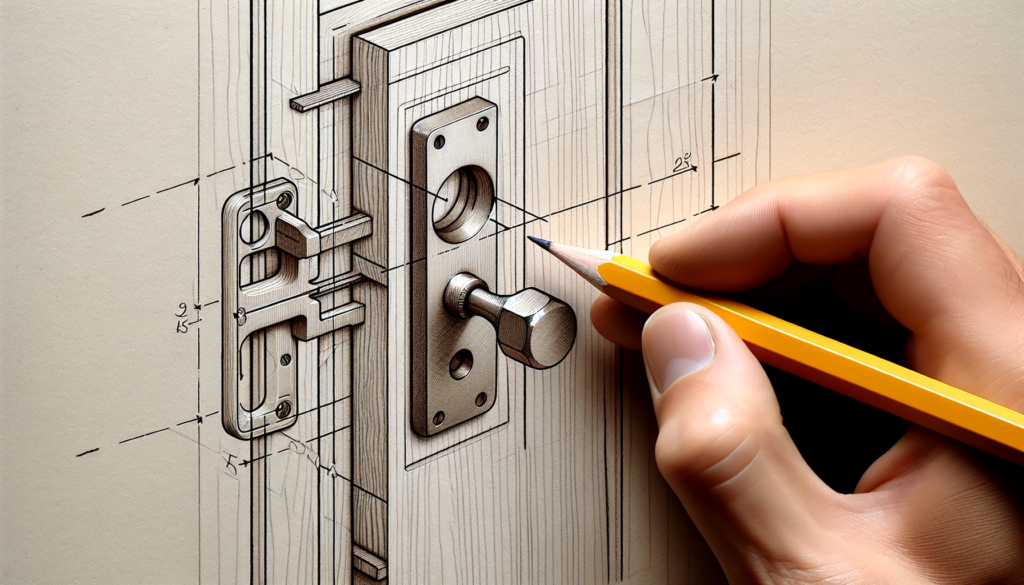
Finding the perfect spot for your strike plate involves a few steps:
- Use a template or coat the latch bolt with lipstick to mark where it meets the frame as the door closes and locks.
- Measure a specific distance from the jamb’s edge and make a cross mark.
- This will set the stage for the strike plate’s installation.
Close the door, let the bolt adorned in lipstick romance the frame, and there you have it – the precise location where your strike plate will call home.
Using a Template for Accuracy
The key to a seamless union between the door and its frame is precision in this task. A template, your steadfast guide, will lead you to trace the precise boundaries where the strike plate will reside. With a utility knife and pencil in hand, you are ready to etch the locations that will welcome the screws and hold your strike plate in an enduring embrace.
Ensuring Proper Alignment with the Latch
Alignment is paramount in the delicate balance between latch and strike plate. When the fit is off by even a whisper, use the imprint method – a touch of lipstick or a similar substance on the latch or deadbolt – to transfer its longing onto the jamb. Tape or putty can hold the latch in place, guiding you to the spot where the strike plate will fulfill its destiny.
Should the misalignment be significant, be prepared to adjust the door’s hinges, for a door well-hung is a door well-secured, especially when it comes to interior doors.
👉Also Read: Guardians of Your Home: Unbeatable Residential Locksmith Services in Las Vegas, NV
Creating the Recess for the Strike Plate
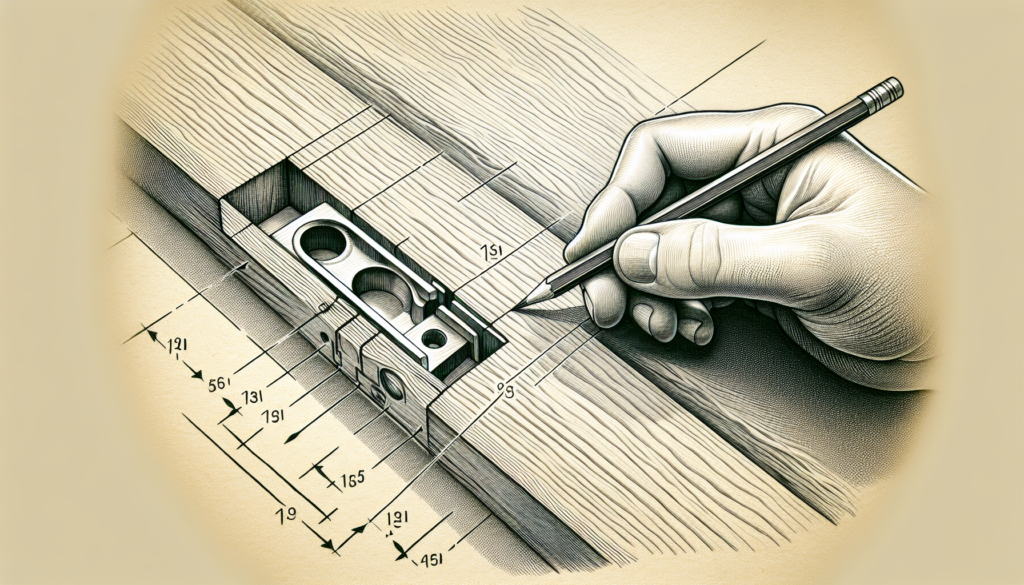
In the tale of transformation known as the creation of the recess, the door jamb is shaped to welcome the strike plate into its fold. Here’s how to do it:
- Mark the outline where the plate will nestle.
- With chisel in hand, carve out the wood to the thickness of your chosen guardian.
- If you doubt your hand’s steadiness, a router with a template offers a path to precision, especially for those less accustomed to the art of chiseling.
Yet, whichever method you choose, the strike plate must rest within its recess as if it were made for it, ensuring the door latches securely, as it was meant to be.
Marking the Outline
Starting with the strike plate aligned with the jamb is a prelude to the union that will ensure security. With utmost care, trace its outline, a delicate task that sets the stage for the fastening to come. Observe the shifts in door alignment, and mark any necessary adjustments to the placement of screw holes during this meticulous process.
Chiseling Out the Recess
The craft of chiseling out the recess involves a careful layout and removal of wood to form the bed where the strike plate will lay.
Once the wood is removed, sand away any imperfections, leaving a smooth surface free from the threat of splinters.
Drilling Screw Holes and Installing the Strike Plate
Once the recess is carved, it’s time for drilling the pilot holes that will embrace the screws and secure the strike plate in its rightful place. These holes are the anchors for the screws that will bind the strike plate to the jamb, ensuring the door latch engages with a satisfying click.
With the pilot holes ready, align the strike plate with them and fasten it with screws, completing the rite of installation.
Drilling Pilot Holes
For this delicate task, a miniature drill bit, no bigger than 3/32nds of an inch, is your ideal choice. It will make a precise entry into the wood, just the right size for the screws you’ll be using later. Remember, a gentle touch is key here. Applying too much pressure could damage the wood and compromise the strength of your project.
With the mortise ready and the pilot hole drilled, the stage is set for the strike plate to be affixed, ensuring the latch operates with effortless grace.
Securing the Strike Plate
Now comes the moment of truth, as the strike plate is poised against the jamb. Close the door gently, guiding the plate into position, ensuring the latch does not displace it. Secure it firmly, and feel the satisfaction as each screw turns, binding the plate to the jamb, a symbol of security and peace of mind.
Testing and Adjusting for Smooth Operation
Once the installation is complete, testing the alignment of the door latch with the strike plate is the next step. Here’s how to do it:
- Employ a dry-erase marker or lipstick on the latch or deadbolt.
- Close the door to leave a mark on the strike plate or the tape placed over it.
- Examine the mark to determine if the latch engages properly with the strike plate.
Misalignment, which could be due to door warping or loosened screws, may require adjustments to ensure perfect harmony between the door latch and strike plate.
Checking the Door Latch Alignment
Studying the mark left by the latch on the tape covering the strike plate can help uncover any misalignment. The position of this mark will reveal if the latch and strike plate are indeed aligned as they should be. If misalignment is present, before making any bold moves, first try tightening the hinge screws and use cardboard as shims behind the hinges.
This simple adjustment could realign the latch with the strike plate, restoring the seamless operation of your door.
Making Fine Adjustments
If the strike plate requires repositioning, it should be removed and the latch mechanism used to pinpoint the new location, temporarily securing it with double-sided tape or putty. If the hole in the strike plate must be enlarged for better engagement, do so with precision and care.
Drill pilot holes at the marked locations and fill the old ones with toothpicks and glue. Once the new position is established, secure the strike plate and revel in the smooth operation of your fortified door.
Enhancing Door Security with Additional Measures
While the strike plate is a vital component of your door’s defense, it’s just one facet of a comprehensive security strategy for exterior doors. To fortify your entryway further, consider using longer screws to reinforce the doorjamb, making it resilient against the forceful advances of intruders.
Remember, locks are more than mere mechanisms; they are the guardians of your home, deterring those with ill intent and protecting your sanctuary and the treasures within.
Considering Additional Locks and Security Features
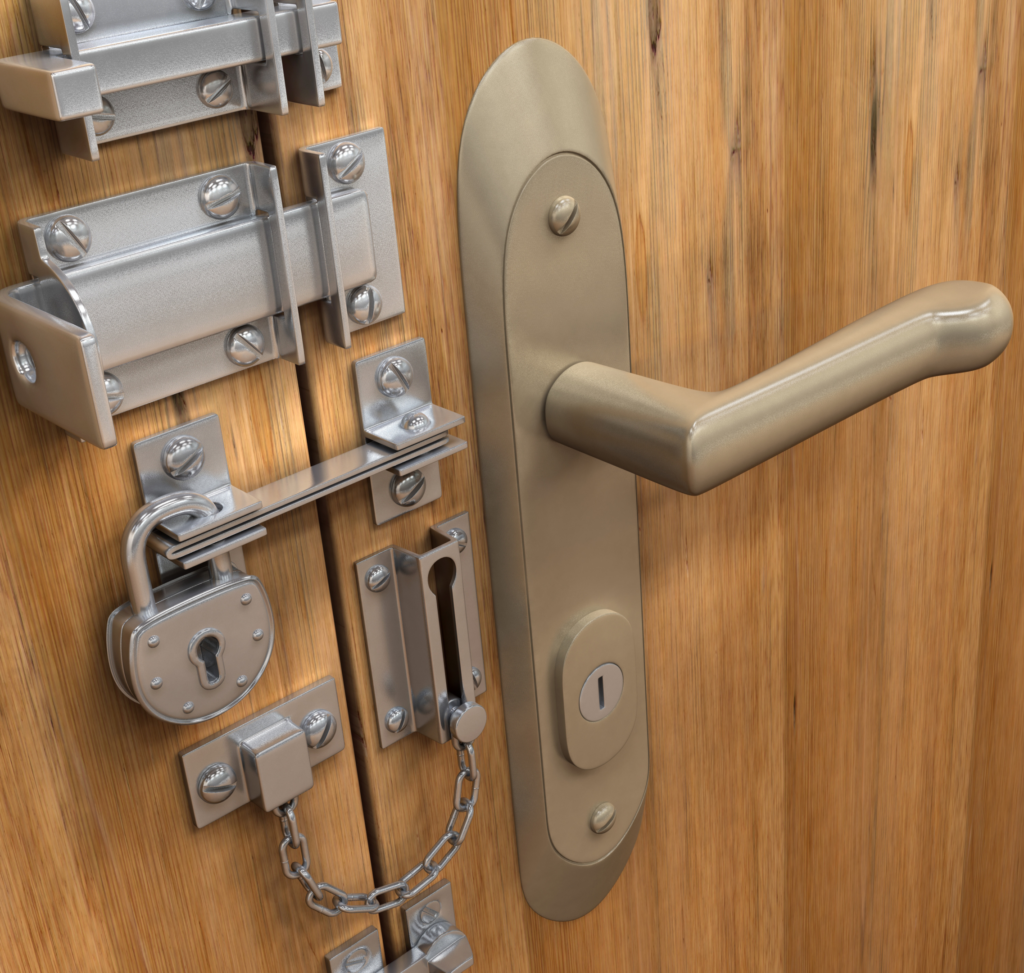
A plethora of additional locks and security devices await to bolster your defenses beyond the strike plate. Here are some options to consider:
- Deadbolts
- Portable door locks
- Door reinforcement locks
- Jammer bars
- Swing bar guards
You can also strengthen your lock’s grip with 3-inch long screws and consider ballistic-grade steel hinges for unmatched security.
Embrace the new era of smart home systems, biometric locks, and commercial-grade options, securing your home without compromising on aesthetic appeal. And for those seeking the pinnacle of security, professional locksmith services provide specialized installations and tailored consultations to fit your unique needs.
👉Also Read: Upgrade Your Home Defense: Full-Service Mobile Locksmith for Strike Plate and Door Lock Bolt Solutions
Secure Your Doors Today! Call Silver Eagle Locksmith for Expert Service
As we conclude our journey, we’ve traversed the realms of door security, from selecting the right strike plate to perfecting its installation. We’ve gathered tools, prepared with care, and ensured that every detail contributes to a secure and smoothly functioning door. But beyond the strike plate lies a world of additional security measures and the expertise of professionals ready to fortify your home. Embrace these layers of protection, and rest assured that you’ve taken a significant step in safeguarding your haven.
Don’t settle for anything less than optimal door security! Silver Eagle Locksmith, your trusted Las Vegas locksmith, offers a complete suite of services for your home or business. From lock installation and key duplication to lock changes and emergency lockout assistance, our certified professionals are here to help. Fully bonded, insured, and licensed, we provide reliable service you can count on. Plus, with our convenient mobile locksmith services, we bring fast and professional security solutions directly to you. Call Silver Eagle Locksmith today at 702-539-9581 and experience peace of mind!
Frequently Asked Questions
What is the purpose of a door strike plate?
The purpose of a door strike plate is to reinforce the doorjamb and provide an anchor point to keep the door securely closed. This metal plate receives the lock bolt or latch, adding extra security to the door.
How do I know if my door strike plate is aligned correctly?
If the mark from the latch or deadbolt is centered in the hole of the strike plate when the door is closed, then the strike plate is aligned correctly. Any misalignment should be corrected by adjusting the strike plate’s position or the door hinges.
Can a strike plate improve my home’s security?
Yes, a well-installed high-security strike plate can significantly enhance the strength of your doorjamb and resist forced entry attempts, making it an important part of your home security.
Should I install the strike plate myself or hire a professional?
It’s important to install the strike plate with precision for its effectiveness. If you’re not confident in your skills, it’s wise to hire a professional locksmith for proper installation and added security.

